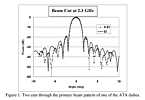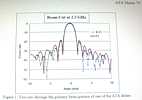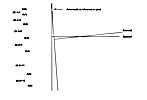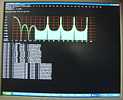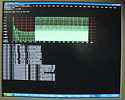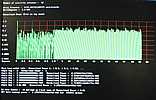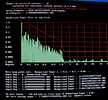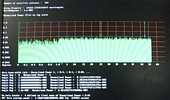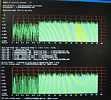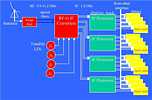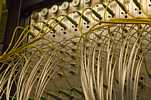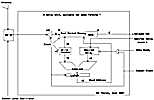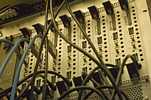Hat Creek ATA - Struggling On
techie wise ;-))
Introduction to this web page
Collection of interesting links
questions
| What a pip - I think we would like to convert local sidereal time and celestial coordinates of target
to pointing azimuth and elevation. Then precise pointed location of the "front end" each antenna to variable delays of each data stream.
|
ATA Memo synopsis - (ATA) Memoranda Index The index also includes links to abstracts in HTML format.
| # | remarks- | ||||||||||||||||||||||||||||||||||||||||||||||||||||||||||||||||||||||||||||||||||||||||||||||||||||||||||||||||
| 74 |
| ||||||||||||||||||||||||||||||||||||||||||||||||||||||||||||||||||||||||||||||||||||||||||||||||||||||||||||||||
| 73 | ATA Correlator - Feb 2007 - two production correlator modules with 8 inputs each (FX8) were
installed Jan 2007 - samoled L band analog IF at 800 MHz, probice 100 MHZ input to FX correlator.
61,425 basselines to correlate - 30 KW per tuning - Linux - Progress has been hampered by the fact
that the ATA analog to digital, digital dela and fringe rotation system is still in development ...
Polyphase filter vs Fourier transform - RF images of M31, M33
|
|
| 72
| ATA Servo Loop - Nov 2006 - lowest resonate frequency = 3 HZ elevation and azimuth frequencies to avoid in
drive. Dirrectly-coupled, incremental encoders step size 9 arc seconds. read @ 19 HZ. Azimuth velocity limited
to 3 degree/sec, elevation 1 degree/sec. Kalman filter.
| 71.
| Cross Correlating Interferometer Beams for Discrimination of Radio ETI Signals
| 70.
| The ATA Imager Update
| 69.
| Initial Test Experiments with a Beamformer at the Allen Telescope Array R. Ackermann, August 5, 2005
| 68.
| Some Thermal Issues Regarding the ATA Node Air System W. J. Welch, March 23, 2005
| 67.
| Noise testing of the active and passive baluns for the ATA N. Wadefalk and S. Weinreb, September 7, 2004
| 66.
| Expected Properties of the ATA Antennas W.J. Welch and D.R. DeBoer, July 18, 2004
| 65.
| Holography at the ATA G.R. Harp and R.F. Ackermann, March 23, 2004
| 64.
| Frequency Coverage of the ATA Front-End (Draft) et al, March 19, 2004
|
63.
| Notes on Deuterium Detection with the Allen Telescope Array G.C. Bower and M.C.H. Wright, February 13, 2004
| 62.
| Automatic Interference Mitigation in Large N Correlator Systems Using an Eigenfilter
W. L. Urry, January 15, 2004
| 61.
| Pointing the ATA Dishes G.R. Harp, D.R. DeBoer and G.C. Bower, December 3, 2003
| 60.
| Measurements of the Allen Telescope Array Performance as an Interferometer D.R. DeBoer and R.A. Ackermann, November 23, 2003
| 59.
| Imaging With a 32-Antenna Allen Telescope Array M.C.H. Wright and G.R. Harp, October 6, 2003
| 58.
| J-MIRIAD: Java Wrappers for MIRIAD Methods G.R. Harp and M.C.H. Wright, October 6, 2003
| 57.
| Beamforming for Blind Surveys at the ATA G.R. Harp, September 11, 2003
| 56.
| Generation of Unwanted EM Modes in the ATA Feed Dewar W.J. Welch, June 30, 2003
| 55.
| Phase Stability of ATA Fiber Optic Cables J.W. Dreher, March 19, 2003
|
54.
| Tests of an ATA Amplifier and Fiberoptic Link R. Plambeck, J. Cartwright and D. Thornton, January 13, 2003
| 53.
| EPFD Measurements on GPS and Iridium at the RPA N. Imara, January 7, 2003
| 52.
| Allen Telescope Array Imaging M. Wright, November 25, 2002
| 51.
| Customized Beam Forming at the Allen Telescope Array G. R. Harp, August 12, 2002
| 50.
| The Antenna Configuration of the Allen Telescope Array D.C.-J. Bock, January 8, 2003
|
|
|
|
|
|
| 47.
| Wide Field Imaging Issues for the ATA R. Ekers and G. C. Bower, April 4, 2002
| 46.
| Broadband Amplitude Calibration of the ATA W. J. Welch and D. C.-J. Bock, March 28, 2002
|
|
|
|
|
|
| 32.
| Notes on Configuration for the ATA T. T. Helfer, September 18, 2001
|
|
| 30.
| Astronomical Imaging with the ATA - III M. Wright, May 22, 2001
|
|
|
|
|
|
| 21.
| 350-Antenna Sample Configurations for the Allen Telescope Array D. Bock, March 26, 2001
|
|
| 17.
| Effects of the Sun and RFI on the ATA Offset Gregorian Antenna (Revision history) D. DeBoer and G. Bower, March 1, 2001
|
|
| 11.
| Astronomical Imaging with the Allen Telescope Array - II. M. Wright, November 1, 2000
| 10.
| The FFT as a Filter Bank. W. L. Urry, October 30, 2000
|
|
| 05.
| The Winds of Hat Creek. D. R. DeBoer, July 11, 2000
|
|
|
|
|
|
|
|
|
|
| --.
| not discussed ?,
|
|
Apparently understanding the overview of the ATA RF collection scheme
is not too tough.
The previous page hinted at everything other than antenna placement and back conversion to RF.
Assuming you have understood the ideas of:
- Antenna placement (what pattern on your plot of land is near optimal)
- Antenna design and operation (both reflector and receiving elements)
- Antenna pointing (both command origination, command chain, servoing)
- Focusing of selected frequency onto which part of the receiving elements
- Physical offset of the receiving elements due to aiming and warping due to wind and heat
- Low noise RF amplifiers
- Conversion of RF to fiber optic light at the antenna
- Fiber optic delay - length determination and correction of timing of
- Conversion of fiber optic light to RF at the central processing facility
Lets try to synthesize this fictitious steerable 300 meter from our various RF streams, forming one steered RF stream.
I choose the beam forming method (forming a square law of the power) because I haven't a clue about the alternative method, correlation.
OK - lets begin
The staff and radio astronomer(s) have chosen:
- has instructed the software about limitations of each antenna performance
- down, limited tracking, limited frequency, too noisy for some work, ... who knows
- Which general "target" to track, and set up the tracking software to point the antennas
- ("Our" actual target needs to be with in some angle of this general target)
- Which if not all antennas "we" will use, subsets of antennas can theoretically be used.
- The software is configured for "our" subset of antennas
- Which ?100? megahertz wide band in the roughly 500 megahertz to 11 gigahertz RF spectrum of the system
- Something/body configures the band limiting filters?, the heterodyning oscillators and post mixing filters
- we now have our IF data stream (100 megahertz baseband) from each of the selected, enabled antennas
- Now we choose which of the 16 subchannels per antenna to feed our signal into
- A number of investigators can use our antennas, the common IF is fed into "our" subchannel(s)
- down, limited tracking, limited frequency, too noisy for some work, ... who knows
To synthesize our 300 meter telescope, we need to get all of these streams into a common phase. The optical telescope people talk of flattening the wave front.
| The greater the aperture (distance between the most distant antennas) the smaller the possible beam width for a given
frequency (beam width is largely the inverse of the antenna in wavelengths - the more wave lengths, the narrower
the beam). A narrow beam enables:
However, since there are a number of discrete antennas, rather than one continuous 300 meter dish, side lobes appear. There is a grand science and art of trying to balance small beam width and minimal side lobes. |
One of the simplest beam forming arrays is the smooth "circular" aperture, implemented as a circular parabola.
Nice and simple, all one piece, ...
|
| 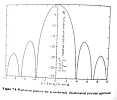
|
| And if you add a feed horn or reflector (usually requiring supports in the beam) the pattern starts getting messy |
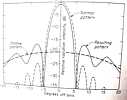
|
This is a 2D simulation of side lobe power of 350 randomly placed ATA antennas in a 70,000 wavelength diameter circle -
no attempt at optimization. Focus is vertical, center white dot, Normalized power there is = 1.0.
code. See this memo
for a fuller view of the complexities involved.
|
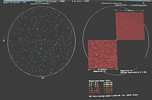
|
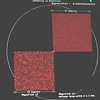
|
| The above simulated images of a random un-optimized field of ATA antennas might look optimistic.
Looking at the lower right square which was approximately corrected for the beam width of an ATA antenna
at 2.3 gigahertz seems visually good -
|
| Lets assume that the antenna farmers (the folks who decide where to place the antennas) do a much much better job -
|
| The above simulations and discussion does not approach nulling of the array to reduce the effect of one or more serious serious RFI sources. Your attention is drawn to the "null steering" part of Customized Beam Forming at the Allen Telescope Array G. R. Harp, August 12, 2002 |
----------------------------------------------------
and computers and Trigonometry and Time
|
So, taking off the gloves,
|
Beam Former - Visit to Berkeley Oct 22,2007 - to Geoff Bower GBower (at) astro.berkeley.edu & a seminar
There are indeed four independent dual channel (for polarization data) per plug-in chassis (above).
I pressed for more details, and maybe drawings,
but Geoff suggested that I really go to the site
to get more details.
-----------------------------------
comments on the above section by Matt Dexter - Sept 2008
To allow a wide pointing angle (approaching 90 degrees), we should allow for delay times of plus/minus 350 meters. This is about
14,000 wavelengths a 11 MHz. To reduce noise and errors caused by delay units, probably we should allow at least 10 delay increments
per wave length. The delay counters should be plus/minus almost 320,000 counts. A count of 2^20 can represent over 1,000,000 counts.
In a previous paragraph we showed that there is about 1 wavelength shift per second at 11MHz. To allow 1/10 wave length error,
the delay unit must be updated about 10 times per second max. This starts to stress conventional updates from a normal computer -
so additional help must be applied to obtain adequate synchronization of delay data updates. This can be achieved by allowing the computer to update buffers and controls on say a ten second basis, then the clock system can send a sync pulse to update
all delay controls simultaneously. The computer obviously needs access to a good (sidereal) clock.
Collection of stuff
Visit to Geoff Bower -
I referred to my drawing (above) of a possible
Delay Unit - suitable for Beam Forming
(at much lower data rates - present FPGAs are too slow for the above configuration at 800 mHz, or even 80 mHz?)
Apparently both summing and correlation are used after
the above delay unit
(Goeff actually said something was "down converted"
to 200 mHz - but that confused me.
So I changed the words and meaning to the above.)
The trip was fun - but did not increase my understanding
I guess I should have taken up digital filtering !!
Does the quadrature output from a quadrature type mixer (or balanced detecter?)
add information (about the phase of the local oscillator?) and is it useful?
I hope I got some of the above correct -
Regarding
http://ed-thelen.org/ATA/HatCreekATA-StrugglingOn.html#BerkeleyOct22
Our current FPGAs could not fit the interpolating filters to get
to delay steps finer than the 838.8608MHz sample clock resolution.
Just not enough gates. 1/838.8608MHz is as fine of delay step
as is supported at the moment.
At this time only the FPGAs programmed for the Transient Search, aka Fly's
Eye, experiment have fine channel gain correction on the 8bit I + 8bit Q
voltage samples just after the digital down conversion. The FX correlator
has gain correction on the F engine's output 1024 spectral channels which
are 4bit I + 4bit Q voltage samples.
There are two usual ways to collect data from objects using radio telescopes:
Lets put in some numbers for a phased array about the size and frequency of the Allen Telescope Array - lets assume a maximum
diameter of 700 meters, a radius of 350 meters. 350 meters times sin(0.25 degrees) = 1.53 meters per minute or 0.0255 meters/second
or about 2.55 centimeters/second. This is about one 11 MHz wavelength per second (the top ATA frequency).
Collection of words
some declination stuff - latitude
Variability of Terrestrial Latitudes http://www.1911encyclopedia.org/Latitude
some ascension stuff
